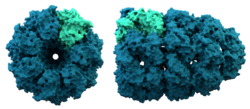Hsp60
| Heat shock protein 60 kDa | ||
|---|---|---|

|
||
| GroEL-GroES chaperonin complex | ||
| other names |
Chaperonin, GroEL |
|
| Mass / length primary structure | 60 kDa | |
| Cofactor | ATP | |
| Identifier | ||
| Gene name (s) | HSPD1 | |
| External IDs | ||
The class of 60 kDa - heat shock proteins , also chaperonins called, are one of the main components of the chaperone system in the cells of bacteria and eukaryotes . Chaperonins help newly synthesized proteins to fold their physiological secondary structure . In eukaryotes, Hsp60 proteins are only located in the mitochondria . Vertebrates such as humans have only the HSPD1 - gene coding for a Hsp60 coded . Mutations in this gene are responsible for hereditary forms of spastic spinal paralysis and leukodystrophy .
Classification
Hsp60 proteins are divided into two classes:
- Class 1 consists of Hsp60 in mitochondria and GroEL in bacteria , proteins that form 7-membered ring-shaped "barrels", the "lid" and "bottom" of which each consist of 7 molecules of Hsp10 or GroES.
- Class 2 consists of the cytosolic chaperonin CCT (also c-cpn or TRiC) in higher eukaryotes and the thermosome in archaea . These proteins form 8- to 9-membered rings. Here the “lid” and “bottom” of the “barrels” are formed by outgrowths of the tertiary structure of the proteins themselves.
function
GroEL is required in the synthesis of an estimated one third of all medium-sized (30-60 kDa) bacterial proteins. Unfolded amino acid chains bind unspecifically to GroEL (that is, many different proteins can bind to GroEL as a substrate), are enclosed and can take on their physiological structure inside the chaperonin complex. After a cycle of ATP hydrolysis on the 7 GroEL subunits, the folded substrate protein is released.
CCT has a much more limited range of substrates. Here, unfolded proteins specifically bind to one or more of the CCT subunits. The proteins that CCT need as a folding aid include the cytoskeletal proteins actin and tubulin , some actin-like proteins, and apparently only a few others.
See also
literature
- Hartl FU: Protein folding. Secrets of a double donation . In: Nature . 371, No. 6498, October 1994, pp. 557-9. doi : 10.1038 / 371557a0 . PMID 7935786 .
- Kim S, Willison KR, Horwich AL: Cystosolic chaperonin subunits have a conserved ATPase domain but diverged polypeptide-binding domains . In: Trends Biochem. Sci. . 19, No. 12, December 1994, pp. 543-8. PMID 7846767 .
- Hemmingsen SM, Woolford C, van der Vies SM, et al. : Homologous plant and bacterial proteins chaperone oligomeric protein assembly . In: Nature . 333, No. 6171, May 1988, pp. 330-4. doi : 10.1038 / 333330a0 . PMID 2897629 .
- Thirumalai D, Lorimer GH: Chaperonin-mediated protein folding . In: Annu Rev Biophys Biomol Struct . 30, 2001, pp. 245-69. doi : 10.1146 / annurev.biophys.30.1.245 . PMID 11340060 .
Individual evidence
- ↑ UniProt P10809
- ↑ Krishna KA, Rao GV, Rao KR: Chaperonin GroEL: structure and reaction cycle . In: Curr. Protein pept. Sci. . 8, No. 5, October 2007, pp. 418-25. PMID 17979757 .
- ↑ Chaudhuri TK, Verma VK, Maheshwari A: GroEL assisted folding of large polypeptide substrates in Escherichia coli: Present scenario and assignments for the future . In: Prog. Biophys. Mol. Biol . 99, No. 1, January 2009, pp. 42-50. doi : 10.1016 / j.pbiomolbio.2008.10.007 . PMID 19027782 .